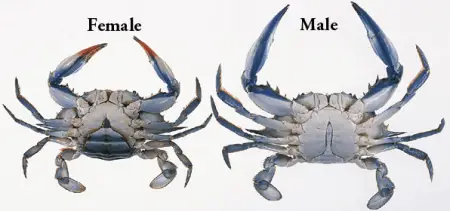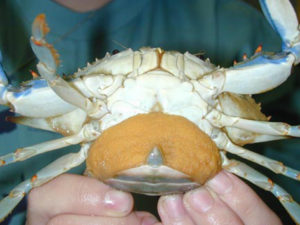
She said it is believed that they don't have the ability of reproducing with themselves, as a hermaphrodite is at times able, but that they might be a possible mate for another crab.
Blue crab male vs female driver#
The creatures were formerly a major economic driver in the area but their numbers have reduced because of overfishing and pollution. Marine biologists at VIMS are researching the uncommon genetic condition to get a better understanding of breeding and sexual development in blue crabs, according to Meagher. It can possibly be impacted by water temperature or hormone levels inside the womb of the mother. Bilateral gynandromorphism doesn't take place in mammals, but has been noticed in lobsters, butterflies, crabs, bees, snakes, chickens, and other birds. It is dissimilar to 'hermaphroditism,' when just the sex organs are impacted. (Photo : Getty Images) Breeding and Sexual Development in Blue CrabsĪ cell doesn't split its sex chromosomes in the usual fashion at some point, bringing about uneven distribution of sexual characteristics, from coloring to reproductive organs. Meagher said this condition is a cellular aberration that is believed to take place when the crab is still in its egg form. Meagher said: "Our crab's claws are not showing this as clearly, but we are identifying it more and more every day as it settles into its new abode and receives nutrient-rich meals."īilateral gynandromorphy, when the division of characteristics is split down the middle, often arises very early in the development of an organism, when it possess just between 8 and 64 cells. In a 'sook,' or a female, the pincers are pinkish and the underbelly is rounded, 'like the Capitol dome'.Īn expert in animal husbandry at the Delmarva Discovery Museum, September Meagher, told the male claw is bluer and the female claw is less blue and tipped with red. SookĪccording to Virginia Institute of Marine Science (VIMS), in a 'Jimmy', or a male blue crab, the underbelly is pointed 'like the Washington Monument,' while the claws are a deep blue. Instead of throwing it in his catch, Smith, a crabber for over four decades, gave it away to the Delmarva Discovery Museum, where it now gets to lounge all over in its own 70-gallon tank.Īlso Read: Heavyweight Crustacean: Coconut Crabs Can Pinch Like Lions, Lift More Than 66 Pounds Jimmy Vs. Chesapeake Bay Magazine reported that Waterman Jerry Smith captured the newest one. Generally, male blue crabs possess blue claw tips and a T-shaped apron, while females possess red tips and a wide apron. In at least 15 years, a gynandromorphic crab hasn't been reported on the Eastern Seaboard. It possesses both red and blue-tipped claws and an underbelly, or apron, that is split right down the center. This crab, which has an extremely uncommon condition referred to as bilateral gynandromorphy, is approximately 4-and-a-half inches long and evaluated to be in its third year.

The changes in female behaviour are consistent with the female's need to avoid the costs of guarding and suggest that females influence how pre-copulatory mate guarding occurs in this species.Copyright 1998 The Association for the Study of Animal Behaviour Copyright 1998 The Association for the Study of Animal Behaviour.(Photo : Getty Images) Bilateral Gynandromorphy Large males were more successful at take-overs, but did not pair more often with late moult-stage females, suggesting that large males do not consistently guard for less time than small males. The pre-mating behaviour of both sexes also varied with sex ratio when males were abundant, males traded courtship for forced capture and females courted less. In the field, early moult-stage females were paired less often than late moult-stage females. Males courted and paired with late moult-stage females on their first attempt, but pursued early moult-stage females because their first attempts to pair often failed. The changes in female behaviour influenced both the behaviour and pairing capability of males. Female behaviour changed as they progressed through the final moult cycle, such that early moult-stage females avoided males, but late moult-stage females initiated pair formation. I learned that female crabs have a circular triangle on the back of them, and that males have this long triangular shape, and thats what I learned Scroll. We observed crabs in field enclosures and surveyed pre-copulatory mate-guarding patterns in the field. We tested the influence of female moult stage, sex ratio and male size on the pre-mating behaviour of both sexes, and the ability of males to pair with females and aggressively compete for access to females.

Blue crabs mate immediately after the female's final moult.


 0 kommentar(er)
0 kommentar(er)
